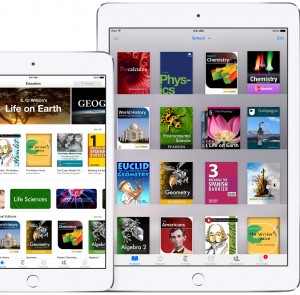 I did some more e-book reading with my students this week.
I did some more e-book reading with my students this week.
Now I’m starting to understand a little better what the current limitations are to using this technology in a classroom setting.
My Exhibit A is iTunes‘s sharing limitations.
I was trying to make collections. We have downloaded about fifty books, mostly free, but a few paid ones. I wanted to organize them onto shelves so that students in different classes could easily access the content which was meant for them. I didn’t want to manually set up the shelves on each and every iPad, so I poked around in the settings and found a ‘share collections’ function. I turned it on, moved onto the next one, turned it on…
And then a few devices in, I got an error message that I had associated the maximum number of devices already. I was confused. I knew there was a limit to how many Apple devices you could register for one account, but I had thought we were still within it. All of our school iPads are linked to the same account, and I have been merrily downloading apps between them for years now.
Important distinction
Alas, there is an important distinction I had not taken into account: device limit and content limit are two separate things. I checked a few Internet help boards (such as this one) and found repeated mentions of a five-device limit for “iTunes-purchased content.”
I could still go into my iTunes cloud and manually download the books. But it would not share my collections across more than five of the iPads.
This is, to my mind, a major Achilles heel. How is a teacher supposed to purchase content and roll it out across a whole classroom? And why does this have to be such a convoluted business? I am prepared to accept that if I plan to use the book across more than five devices, it should cost a little more. But I don’t want to set up a new account for it. There has to be a one-tap way to ‘upgrade’ an existing purchase—keep it on my same account, charge me a top-up price on it, and then let me roll it out onto every device I have. Otherwise, what is the point of using these devices in the classroom?
When we first got the class set of devices, we tried to set up a corporate account through Apple. We were unsuccessful in doing so because the requirements were quite onerous. I forwarded the whole thing to my boss when Apple’s first question was, ‘Are you authorized to share tax information with Apple Canada?’ and our IT people came twice to try and do it. It didn’t work out, so we are on a plain old Apple account here.
Maybe there is a ninja way for corporate users to solve this problem. But whatever that way is, it has not been intuitive enough for little old me to figure it out, and I am our school’s technology team-lead. There is no way a ‘regular’ teacher here could make sense of this. Most teachers I know are appallingly short on tech skills. If this isn’t made simple, they won’t do it.
So, what is my solution going to be? I’m not sure yet. I thought about setting up a student Dropbox account and loading books into browsable folders for them. But that limits me to only public domain or purchased-but-DRM-free titles. These kids want to read Captain Underpants! And I don’t blame them for that.
In my perfect world, schools would be able to sign up for a program which uses a web interface to organize content. Pay an annual fee to sign your school up, then each teacher can browse via the website to add books, music, video, learning games and other content from the Netflix-style service to their class account. The student opens an up on their device, taps one button to sign in as class X or class Y, and there is a menu with all the stuff they need. Once that’s underway, we can start adding in some frills like reporting features to show the teacher whose done the reading already.
Anybody read to make such an app? My school would sign up in a heartbeat!


































I’m reasonable sure that Kindle can do this. If you reach the device limit with a book, I think it allows you to purchase an additional copy. I’ve heard people being outraged at the idea of having to do so, but it kind of makes sense to me — you can’t expect to get infinite copies of a book for just one purchase.
Back in the era of the Apple II, the company put a lot of emphasis on supporting schools. Get them hooked early and at school, it seemed to thinking, and then they’ll get parents to buy Apple for their home. That continued for some years with Macs and the hefty discounts offered to college students.
That seems to have faded almost into oblivion. My now-ancient white MacBook was ideal for schools. Rugged, easily upgraded, and easily fixed. Apple hasn’t made anything comparable since. The MacBook Pros are too pricey and designed for affluent travelers. The MacBook Airs are too fragile, devoid of ports and almost impossible to service or upgrade. They’re for people who idle their lives away at Starbucks.
Schools aren’t the only ones being shorted. Creatives, a group as a writer I pretend to be in, aren’t happy either. iMacs are pretty but a pain if they break and that’s death if you’re working under a tight deadline. You can almost get a new car for what a Mac Pro costs and it hasn’t been upgraded in years. I use an older Mac mini back, because the new one is junk, with soldered in RAM and intended as an upscale Apple TV.
Worst of all for the stockholders, most businesses don’t even look at Macs because Apple, with the snottiness of upper-class English sneering at “tradesmen’ doesn’t make what businesses buy, versatile and easily upgradable component systems. Business don’t have the money for iMacs. It means that you have to buy everything at once, need it or not, and everything goes bad if one component goes bad. If a display on my older Mac mini went bad, I’d be up and running with a spare in about ten minutes with a spare that cost me almost nothing. I can’t buy that once decent Mac mini any more and, if I got an iMac, a dead display would costs at least a couple of hundred dollars and put me out of work for a week. For business, Macs stink even worse that for schools.
—-
More and more, Apple is selling to what I call Bourgies (after the French bourgeosie). If you see an expensive car sitting by the side of road with the driver looking at the flat tire totally mystified about how to change it, that’s a Bourgey. They actually like computers that can’t be fixed or upgraded.
They’re also easily duped into thinking the unimportant is important, confusing style with function. In the early 1960s, when I was a kid, such people thought the height of style was a Cadillac with fins. Now they think it is a MacBook Air that’s thin. The fins served no purpose. The thin of an MBA is so excessive it not only serves no purpose, Apple is using it as an excuse to cut the number of ports on laptops to ridiculous levels. Travel with one and you have to carry a bag of adapters to make up for that lack. Dumb, really dumb. But the Bourgey don’t figure that out. After all, fins… errr…. thin is stylish.
——
In your case, a more with-it-for-schools Apple could offer iBookstore authors and publishers a school option. They could specify a different pricing and rules for schools, one that would allow you the copies you need for classroom use. And they could fix all the other troubles and issues you mention. Apple has over $200 billion sitting in banks offshore. It could afford perhaps $20 million to serve schools better.
I’m sure there are people at Apple that’d like to provide the answers you mention, but they’re not the decision makers. Apple’s decision makers like selling only high-end products that are virtually unserviceable. They like quick obsolescence, since that means more profits. They even like posturing ridiculous levels of privacy for iPhones, refusing to open up a company iPhone used by a terrorist/killer. Yet at the same time they’re quietly agreeing to assist the repressive Chinese government in various nefarious monitoring purposes. Calling that hypocritical is an understatement.
—-
Apple is hardly alone. Virtually the entire high-tech world is filled with highly lucrative businesses raking in billions and paying less in taxes than—in the case of the UK—a little corner pub.
http://www.thedrinksbusiness.com/2015/11/uk-pub-tax-burden-slammed-by-study/
http://www.independent.co.uk/news/uk/crickhowell-welsh-town-moves-offshore-to-avoid-tax-on-local-business-a6728971.html
http://www.theguardian.com/global/2015/oct/11/facebook-paid-4327-corporation-tax-despite-35-million-staff-bonuses
And for the U.S.:
http://www.huffingtonpost.com/2013/08/08/small-business-taxes_n_3727270.html
—–
If you’re thinking what I’m thinking, these high-tech companies aren’t just depriving schools of practical technology for the classroom, they’re cheating communities and states out of taxes that support those schools. Why should they care? Their kids go to elite private schools. If your kid gets cheated out of a decent education, it means their kids have less competition in the job market. And yes, that’s the type of anger that is driving Trump and Bernie support. Trump isn’t any better, but he pretends to care. Bernie solutions won’t work, but people like to pretend they will.
——
One suggestion. You might see if you can get a good selection of ebooks for your students from Smashwords. They come in various formats and none include DRM. For details, look at this FAQ:
https://www.smashwords.com/about/supportfaq#drm
And if the books you pick are by less famous authors, all the better.
Good luck. There’s no one I admire more that dedicated teachers. Much like nurses, they’re the unsung heroes of our society.
/EXIT RANT MODE/
–Mike Perry, Inkling Books
Kindle let publishers set a limit too, the default being 6 copies.
If you google [ Kindle Schools] you may be able to find out how Amazon handle school accounts.
Never heard of a “buy another copy” option
The point being that if Amazon has a more sensible deal you can install the Kindle App and buy from Amazon rather thnt iBooks.
I’m sorry Joanna, but, while it’s not easy, Apple has solutions just for you. Again Teleread publishes inaccurate information!.
Like I said it’s not easy. That’s what you should be writing about.
But yes Apple can help you.
My suggestion – go today to an Apple store, show them your post, and they will help you solve this problem.
So mac2net, if you ” go today to an Apple store” and the person you speak to doesn’t even understand your question, who do you ask for ?
Cite that every Apple store has a schools specialist ?
Since the article is critical of Apple, I am taking the position that a visit to an Apple store will definitely clarify the situation. Good luck!
[…] zwar farbenfroh und von Multimedia-Feuerwerk geprägt, doch galt die Praxis unter Pädagogen als einigermaßen haklig und unintuitiv, was das Handling von Geräten und Medien im Detail angeht. Dass Amazon aktuell ebenfalls eine […]